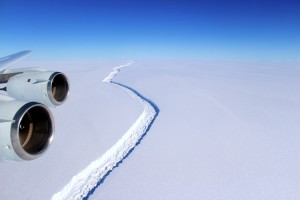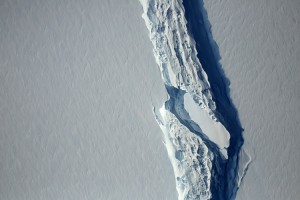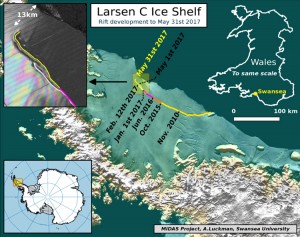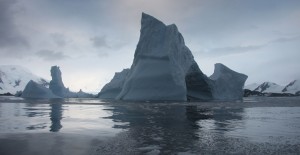Ailing Antarctica
June 22, 2017
In May 2017, scientists watched anxiously as an enormous crack in Larsen C, one of Antarctica’s largest ice shelves, grew by more than 11 miles (18 kilometers) in just a few days. Scientists have been closely monitoring the Larsen C ice shelf, where a large fissure in the ice has been advancing and widening in rapid bursts in recent years. When it eventually breaks away, it will form one of the largest icebergs ever seen.

An airplane passes above the giant crack in Antarctica’s Larsen Ice Shelf in late 2016. Credit: NASA/John Sonntag
The Larsen Ice Shelf is a broad, flat, floating mass of ice in the northwest part of the Weddell Sea. It extends along the east end of the Antarctic Peninsula. Researchers who work in the area originally labeled three segments of the massive ice shelf as Larsen A, Larsen B, and Larsen C (running north to south). The Larsen A ice shelf broke away and disintegrated in 1995. The Larsen B ice shelf disintegrated in 2002. Researchers fear the disintegration of Larsen C, the largest of the three and the fourth largest in Antarctica, will leave the continent’s whole system vulnerable to future break-up.

This airborne photograph shows a detail of the massive 300-foot- (100-meter-) wide rift in Larsen C in late 2016. Credit: NASA Goddard Space Flight Center
Larsen C is substantially larger than its former neighbors Larsen A and B, and its loss would be a huge blow to ice on the Antarctic Peninsula. When the shelf breaks away as an iceberg, it will weaken or destroy key areas where ice overlaps nearby islands. The ice shelf helps keep larger ice masses nearby from falling apart. Losing Larsen C would destabilize and even threaten the existence of the area’s larger ice masses.

Click to view larger image
This map shows the rift on Larsen C on May 31, 2017, and its growth since 2010. The shelf is larger than Wales in the United Kingdom. Credit: © A. Luckman, MIDAS project/Swansea University
Antarctica has about 90 percent of the world’s ice with a volume of about 7.25 million cubic miles (30 million cubic kilometers). The average thickness of the ice is over 7,100 feet (2,200 meters), and the masses contain about 70 percent of the world’s fresh water. Most of this ice lies in two massive sheets that can be as thick as 11,500 feet (3,500 meters). If all that ice melted, Earth’s oceans would rise nearly 230 feet (70 meters), flooding coastal cities around the world.

Antarctica’s Larsen B Ice Shelf broke apart in 2002, forming these icebergs that have since melted and disappeared. Credit: Ted Scambos, NSIDC
Scientists blame the disintegration of the Larsen Ice Shelf on global warming. The ice destruction has destabilized the entire eastern Antarctic Peninsula and raised sea levels. Scientists note that global warming does not affect all parts of the world equally. Average temperatures in Antarctica have jumped 5 Fahrenheit degrees (2.8 Celsius degrees) since the 1950′s, a faster rate of increase compared to other parts of the Earth. Climate scientists think that temperatures could increase up to 7 Fahrenheit degrees (3.9 Celsius degrees) further in the coming decades, putting ever more stress on the ice.
Ice shelves themselves do not contribute directly to sea level rise because they are floating on the ocean and they already displace the same volume of water. But scientists are still deeply troubled by the collapse of Larsen C. In Antarctica, ice shelves act as doorstops to the land-based glaciers that feed them. As ice shelves disappear, the glaciers move faster and flatten out, pushing ever more ice into the ocean and raising sea levels.
Although cycles of cooling and warming as well as other natural processes affect Antarctica’s climate, scientists are largely in agreement that human activities, particularly emissions of heat-trapping greenhouse gases, are the main driving force behind the area’s temperature increases and the resulting loss of the ice shelves. The most significant greenhouse gas is carbon dioxide, which is produced by the burning of such fossil fuels as coal and oil. A number of other atmospheric, oceanic, and glaciological factors are also involved.


